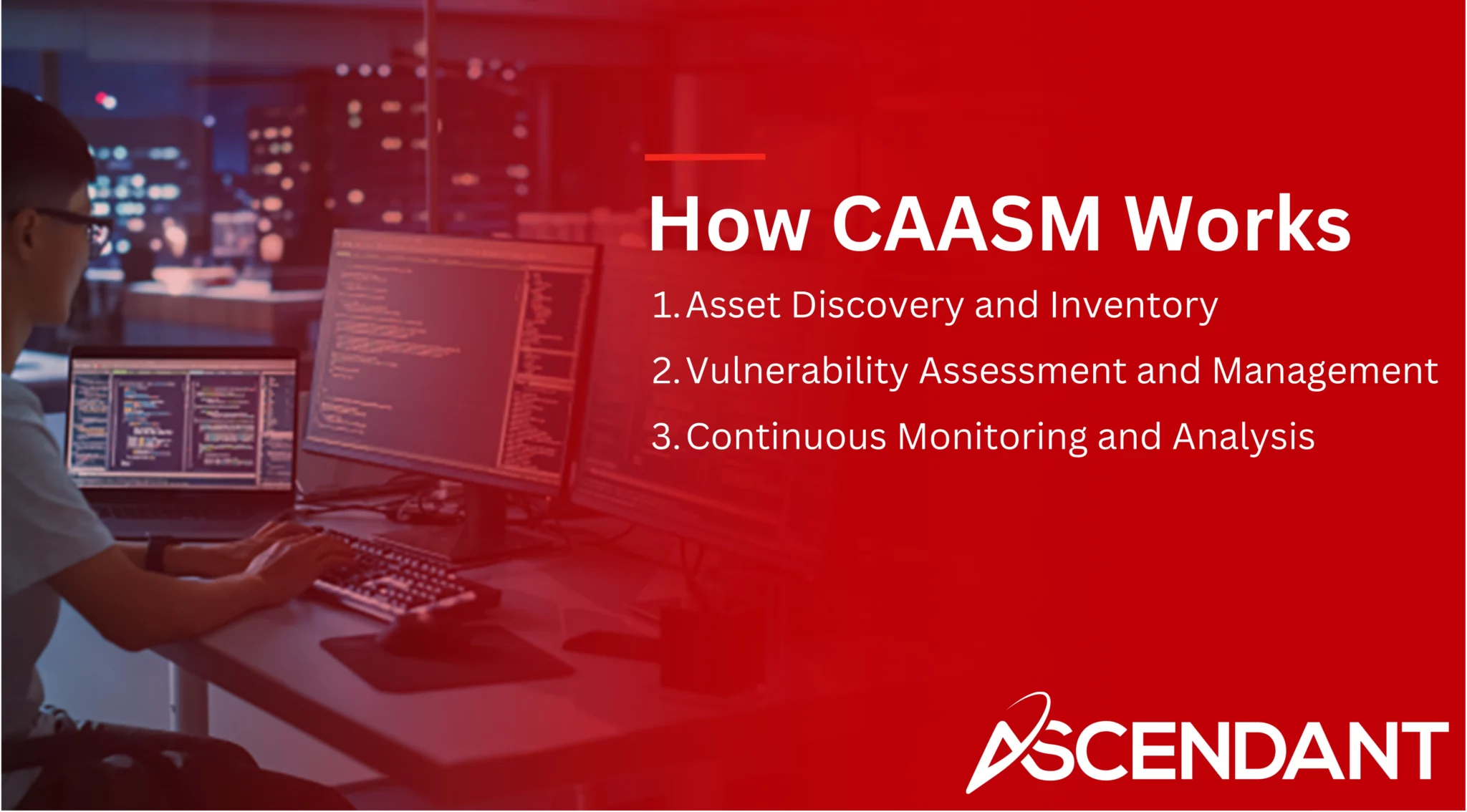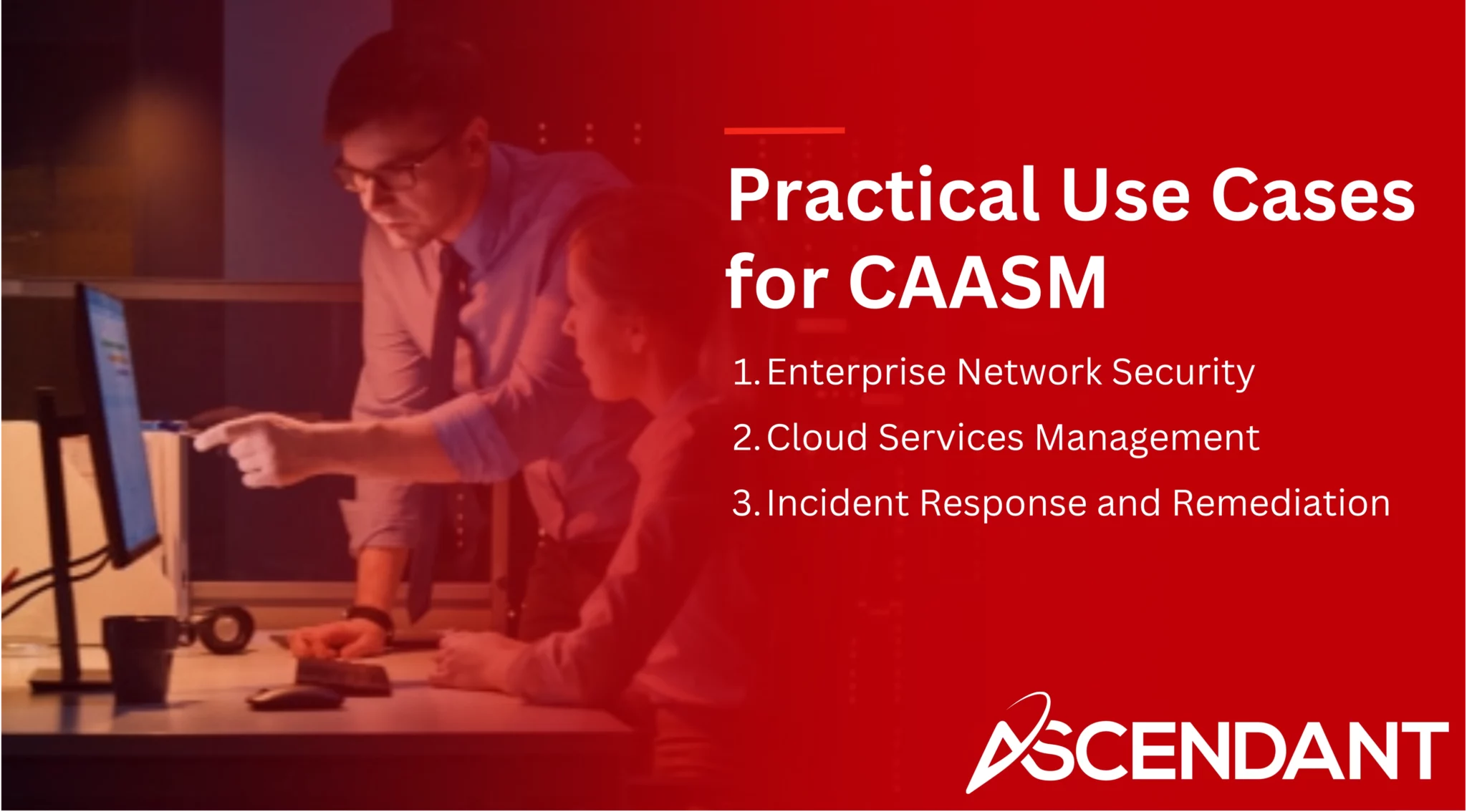CAASM, or Cyber Asset Attack Surface Management, is essential for managing vulnerabilities in today’s complex digital environments. By offering real-time visibility into both internal and external cyber assets, CAASM enables organizations to identify and mitigate risks proactively. In this guide, we’ll explore what CAASM is, why it’s important, and how it can help you strengthen your cybersecurity posture.
Key Takeaways
- CAASM provides a comprehensive framework for managing vulnerabilities across an organization’s cyber assets through asset discovery, vulnerability management, and continuous monitoring.
- Employing CAASM enhances proactive risk reduction and compliance by offering real-time visibility into both managed and unmanaged assets, facilitating early threat detection and response.
- Leading companies utilize CAASM to strengthen their cybersecurity posture, leveraging automation and advanced technologies like AI for effective vulnerability assessment and risk management.
Understanding CAASM
Managing the vulnerabilities present within an organization’s cyber assets is a key component of Cyber Asset Attack Surface Management (CAASM). This cybersecurity discipline melds asset discovery with vulnerability management and risk evaluation to furnish a comprehensive perspective on all internal and external digital resources. Through this integrated approach, organizations can actively pinpoint and control potential security risks in their attack surface, enhancing overall protection against threats.
Definition of CAASM
CAASM serves as an integrated platform that provides a comprehensive view of every physical and digital cyber asset within a company’s network infrastructure. This system covers the processes involved in identifying, assessing, and mitigating vulnerabilities associated with these assets. The main elements constituting CAASM involve continuous monitoring, vulnerability management, and asset discovery. By offering real-time insights into their assets through this collective approach, organizations can enhance their capacity to manage risks related to exposure and security flaws.
To effectively oversee cyber assets, companies must delineate all possible avenues for attack such as endpoints and software applications – thus establishing an exhaustive inventory of assets. Through regular audits and updates, new additions are incorporated into the asset repository ensuring that evaluations remain current with respect to vulnerabilities. Consequently, this ensures upholding a strong security posture, which is pivotal for safeguarding an organization’s information technology landscapes from potential threats.
Importance of CAASM
In the current fast-paced IT landscape, an organization’s attack surface may rapidly increase, presenting a significant challenge in managing risks with efficacy. CAASM steps up to meet this challenge by delivering a comprehensive perspective of the organization’s attack surface, thereby facilitating early threat detection and bolstering its security posture. By integrating CAASM into their operations, organizations can identify and mitigate threats prior to any potential exploitation, strengthening proactive defense strategies.
Conventional asset management solutions were not crafted with cybersecurity as their primary focus. Hence, they fall short in addressing contemporary security demands. The emergence of CAASM has revolutionized these expectations by specifically catering to cybersecurity requirements. It provides extensive visibility over both internal and external assets while pinpointing vulnerabilities that might elude traditional ASM systems.
How CAASM Works
Fundamentally, CAASM operates through the synthesis of asset discovery, vulnerability management, and continuous monitoring. This combination offers a complete perspective on an organization’s digital presence while boosting operational productivity by streamlining processes and diminishing the necessity for intensive manual supervision.
Asset Discovery and Inventory
CAASM is inclusive of both supervised and unsupervised assets within a company, spanning hardware, software applications, and cloud-based services. The process of automating the identification and cataloging of these assets is crucial to CAASM’s effectiveness. This ensures ongoing surveillance as new assets connect or disconnect from the network infrastructure. Common methodologies for this purpose include conducting network scans, utilizing monitoring agents, and implementing API integrations.
The real-time transparency into all cyber-related resources afforded by CAASM extends even to those positioned in cloud platforms or located remotely. It’s vital for sustaining an up-to-date perspective on an ever-changing attack surface. For example, Balbix employs AI-powered techniques that facilitate swift detection of security weaknesses and potential threats with the aim of bolstering safety practices throughout organizational networks.
Vulnerability Assessment and Management
Security teams can better contextualize risks linked to each asset by integrating asset discovery with vulnerability management in CAASM. By evaluating risk factors such as the severity of vulnerabilities, their exploitability, and threat exposure levels, CAASM assists in reducing the attack surface comprehensively. The automation of vulnerability management workflows within this system serves to bolster network security for enterprises by facilitating rapid identification and remediation of risks.
In a practical sense, CAASM delineates digital assets across enterprise networks, pinpointing any vulnerabilities while providing context for every detected asset. This all-encompassing strategy guarantees that potential points susceptible to attacks are swiftly recognized and dealt with accordingly—effectively fortifying the overall security posture.
Continuous Monitoring and Analysis
The implementation of continuous monitoring through CAASM plays a crucial role in the prompt detection of emergent vulnerabilities and exposure to risks. By maintaining an exhaustive inventory of assets, security teams are equipped with the ability to continuously oversee and administer each asset, which significantly improves oversight across the entirety of the organization’s attack surface. For instance, CrowdStrike implements a CAASM strategy that emphasizes preemptive identification of threats by employing real-time data analysis for quick recognition and reaction to imminent security concerns.
Persistent scrutiny and surveillance guarantee swift awareness regarding any modifications or updates pertaining to assets, enabling instantaneous responses. The continual examination provided by CAASM fosters an anticipatory stance towards identifying potential weaknesses and countering threats before they can fully manifest.
Key Benefits of CAASM
CAASM presents numerous key benefits that are essential to contemporary cybersecurity structures, such as improved visibility, the proactive diminishment of risks, and enhanced compliance along with better reporting capabilities.
Enhanced Visibility
CAASM offers a pivotal advantage to security teams by enabling expansive oversight over an organization’s cyber assets, encompassing both managed and unmanaged ones. This approach eradicates any unseen areas and secures a more thorough understanding of the entire attack surface. Top-tier organizations employ CAASM solutions for acquiring such critical visibility that is instrumental in thwarting impending threats.
Incorporating a meticulous asset inventory within CAASM is fundamental as it guarantees that all pertinent information is seamlessly assimilated into the CAASM solution. Providing security teams with this granular perspective on every asset aids them in swiftly identifying modifications or advancements, thereby bolstering their risk management efforts.
Proactive Risk Reduction
CAASM empowers organizations to actively diminish security risks through the scrutiny of vulnerabilities and their subsequent prioritization for correction. Where traditional ASM offers a wide lens on an organization’s digital landscape, CAASM concentrates its efforts on identifying weaknesses within distinct cyber assets. This targeted methodology facilitates enhanced risk management and expedites the neutralization of potential security threats.
When it comes to cloud infrastructures, CAASM plays a crucial role in maintaining compliance by overseeing and administering the protection of cloud assets. By adopting this proactive approach, organizations can detect and address vulnerabilities preemptively, preventing possible exploitations from compromising their overall security posture.
Compliance and Reporting
CAASM is instrumental in aiding entities to fulfill compliance obligations, delivering crucial intelligence for maintaining regulatory conformity. The relentless supervision of assets confirms the uniform application of security protocols, thus enhancing adherence to regulations within cloud infrastructures.
Employing CAASM enables corporations to refine the procedures involved in monitoring alignment with sector-specific norms, making reporting processes more straightforward. Such persistent compliance vigilance guarantees comprehensive asset oversight and defense against potential hazards, sustaining a robust security posture.
Comparing CAASM with Other Technologies
Examining CAASM alongside other technologies elucidates its distinct value and operational extent. This juxtaposition underscores the benefits of CAASM’s focus on assets as a means to bolster cybersecurity.
CAASM vs. Attack Surface Management (ASM)
CAASM transcends conventional Attack Surface Management by extending its focus beyond external threats, thus offering a holistic view of an organization’s cyber asset panorama that encompasses internal vulnerabilities as well. The integrated method it employs paves the way for proactive strategies in risk management, enabling the identification and control of susceptibilities across all assets.
By providing extensive insights into both internal and external aspects of cyber assets and their potential weaknesses, CAASM sets itself apart from traditional ASM approaches. Gaining this broad perspective is critical to modern cybersecurity measures, ensuring thorough understanding and monitoring within contemporary digital landscapes.
CAASM vs. Digital Risk Protection (DRP)
Digital Risk Protection (DRP) is centered on protecting sensitive digital assets against threats originating from outside the organization. In contrast, CAASM integrates asset discovery with vulnerability management and risk assessment to create a unified solution.
By adopting this integrated strategy, an organization can gain a more holistic understanding of its cyber asset environment.
CAASM vs. External Attack Surface Management (EASM)
CAASM provides an inclusive perspective by monitoring both internal and external assets, encompassing a wider spectrum of security risks than what is addressed through External Attack Surface Management (EASM) alone. It delivers a comprehensive grasp of possible security vulnerabilities that EASM may overlook due to its focus solely on external threats.
Organizations benefit from CAASM’s approach as it enables them to address a more extensive range of security concerns stemming from both inside and outside the network. The persistent visibility into all assets afforded by CAASM is essential for sustaining a strong security posture.
Practical Use Cases for CAASM
CAASM enhances cybersecurity across multiple industries by providing thorough asset management and facilitating the proactive mitigation of risks.
Enterprise Network Security
CAASM provides a robust solution for enterprise networks, empowering security teams to recognize and oversee all assets within the IT landscape, whether they are managed or unmanaged. This thorough method allows enterprises to mitigate risks tied to shadow IT by persistently detecting unmanaged assets.
By providing comprehensive attack surface visibility, CAASM facilitates security teams in pinpointing potential security gaps. This capability is crucial in reducing vulnerabilities across multiple attack surfaces effectively.
Cloud Services Management
CAASM is pivotal in safeguarding cloud assets by pinpointing potential weak spots in cloud infrastructures. Utilizing CAASM approaches enables businesses to actively diminish the dangers tied to threats targeting cloud security.
To manage cloud security within CAASM effectively, it’s vital to establish an exhaustive asset inventory and maintain a commitment to perpetual enhancement. Adopting this method guarantees sustained adherence to regulatory mandates while simplifying procedures associated with reporting on cloud security matters.
Incident Response and Remediation
By facilitating rapid detection of vulnerabilities and streamlining prioritization for fixing them, CAASM enhances the efficiency of security teams in managing incident responses. The adoption of CAASM leads to markedly quicker response periods during cyber incidents thanks to its provision of immediate insights into compromised assets.
The unified perspective on assets offered by CAASM expedites the response time when dealing with incidents and simplifies the process involved in remediation post a security infringement. This bolstered capacity for responding to incidents grants security teams the ability to respond more quickly to new threats that arise.
Best Practices for Implementing CAASM
For CAASM to be implemented effectively, it is essential to follow best practices such as incorporating the system with current cybersecurity tools, establishing clear key performance indicators, and involving competent security practitioners in the process.
Comprehensive Asset Inventory
An extensive inventory of assets is crucial for the successful implementation of CAASM. This inventory and associated risk models should be tailored to meet particular business requirements, capturing and handling all pertinent information about assets. It’s important that this detailed listing encompasses every managed and unmanaged asset, offering a full perspective on the enterprise’s cyber assets.
By integrating automatic, perpetual compliance monitors within the management framework, accuracy and completeness are preserved over time in inventory records. Such persistent processes for discovering and monitoring assets aid businesses in surmounting challenges related to asset visibility while upholding a strong security posture.
Cross-Department Collaboration
Implementing Cyber Asset Attack Surface Management (CAASM) effectively hinges on robust communication and collaboration among various organizational departments. It’s essential that IT, security, and additional relevant teams work in concert to coordinate asset management strategies that comprehensively cover the cyber asset attack surface. Assigning distinct roles and responsibilities from the outset is vital for CAASM initiatives to flourish.
When these diverse departments work harmoniously, an organization significantly boosts its capacity for managing security risks efficiently. By weaving CAASM seamlessly into existing workflows within the company, processes are not only streamlined but also bolstered in terms of cybersecurity resilience.
Continuous Improvement
Continuous improvement is essential in CAASM to effectively respond to the dynamic landscape of cyber threats. Regular assessments and updates of security measures ensure the ongoing effectiveness of implemented security controls. This practice fosters resilience against emerging vulnerabilities and enhances the overall defense posture of the organization.
Making continuous improvement a standard practice within cybersecurity frameworks allows organizations to stay ahead of potential threats and maintain a robust security posture while mitigating security risks. This proactive approach is crucial for long-term success in managing cyber asset vulnerabilities.
How Leading Companies Enhance CAASM Capabilities
Top-tier organizations are employing CAASM solutions to achieve an all-encompassing understanding of their cyber assets, thereby fortifying their cybersecurity infrastructures. Insights into optimal practices and effective strategies for augmenting CAASM capabilities can be gleaned by analyzing the implementation approaches of entities such as Rapid7, CrowdStrike, and Balbix in relation to CAASM.
Case Study: Rapid7
Rapid7 has incorporated CAASM within its security operations framework to thoroughly comprehend and control its attack surface while adeptly managing vulnerabilities. The adoption of CAASM bolsters asset visibility and automates countermeasures, thereby enabling the swift detection and resolution of possible threats. It’s essential for Rapid7 to engage in continuous monitoring and analysis for the prompt discovery of emerging vulnerabilities.
In their approach to risk management, Rapid7 actively seeks out and corrects vulnerabilities by utilizing intelligence obtained from CAASM. They utilize this technology to enhance their compliance measures, guaranteeing adherence to legal standards while diminishing potential risks.
Case Study: CrowdStrike
Utilizing CAASM, CrowdStrike strengthens its cybersecurity approach by augmenting oversight and governance of the asset attack surface. The incorporation of CAASM allows for proficient handling of vulnerabilities that span across cyber assets, adopting a forward-thinking stance in risk reduction efforts through dynamic practices like asset discovery, continuous monitoring, and conducting vulnerability assessments.
CrowdStrike’s adoption of CAASM markedly bolsters their preparedness to confront upcoming cybersecurity challenges. Persistent examination of potential security weaknesses and pathways for threats elevates CrowdStrike’s ability to detect dangers before they materialize proactively.
Case Study: Balbix
Utilizing state-of-the-art artificial intelligence, Balbix augments CAASM functionalities. By employing AI, the platform automates and refines the process of pinpointing and appraising vulnerabilities throughout the digital asset environment. This approach empowers organizations with instantaneous comprehensive awareness of their entire attack surface, thus facilitating swift insight gathering and expedited decision-making processes.
Balbix’s strategy involves relentless monitoring coupled with AI-driven analytics to adeptly handle vulnerability management by ranking threats according to their possible repercussions for the organization. Such cutting-edge application in CAASM provides prompt detection and remediation of security risks.
Summary
In summary, CAASM offers an all-encompassing strategy for handling and lessening the dangers tied to a corporation’s cyber assets. It merges asset discovery with vulnerability management and continuous monitoring to bolster visibility, forward-looking risk mitigation, and adherence to regulations. Top-tier firms such as Rapid7, CrowdStrike, and Balbix have proven the efficiency of CAASM in reinforcing cybersecurity structures. Adoption of CAASM can markedly enhance your organization’s security stance and robustness in the face of cyber threats.
 Frequently Asked Questions
Frequently Asked Questions
What is CAASM?
CAASM, or Cyber Asset Attack Surface Management, is a cybersecurity approach that emphasizes the management of vulnerabilities across an organization’s cyber assets by facilitating asset discovery, vulnerability management, and risk assessment.
This practice helps organizations maintain a comprehensive understanding of their security posture.
How does CAASM differ from traditional ASM?
CAASM differs from traditional ASM by offering comprehensive visibility into an organization’s complete cyber asset landscape, including both external threats and internal vulnerabilities.
This depth of insight enables better identification and management of risks.
Why is continuous monitoring important in CAASM?
In CAASM, the practice of continuous monitoring is crucial for quickly discovering emerging vulnerabilities and exposures to risk, which helps in the early detection and countering of threats.
By doing so, it promotes an improved security posture and more effective management of risks.
How can CAASM help with compliance?
CAASM effectively aids compliance by delivering critical insights for regulatory adherence and ensuring continuous asset monitoring, which streamlines reporting practices.
This comprehensive approach enhances an organization’s ability to meet regulatory standards.
What are some best practices for implementing CAASM?
To effectively implement CAASM, it is essential to maintain a detailed asset inventory, encourage collaboration across various departments, and dedicate oneself to ongoing enhancement by consistently conducting evaluations and updates.
By sticking to these recommended practices, the improvement of overall asset management and security can be substantially elevated.



